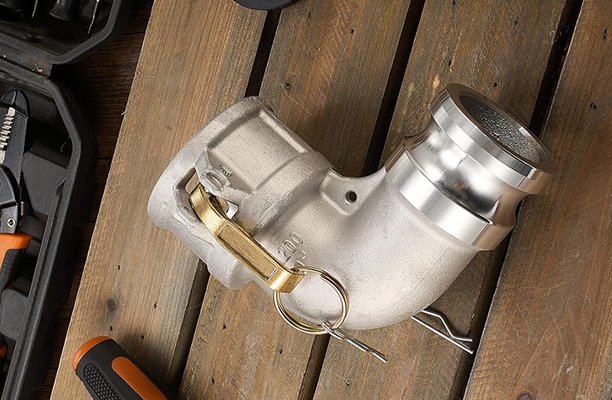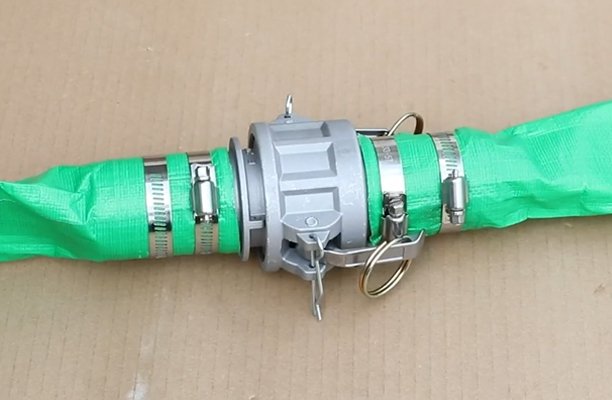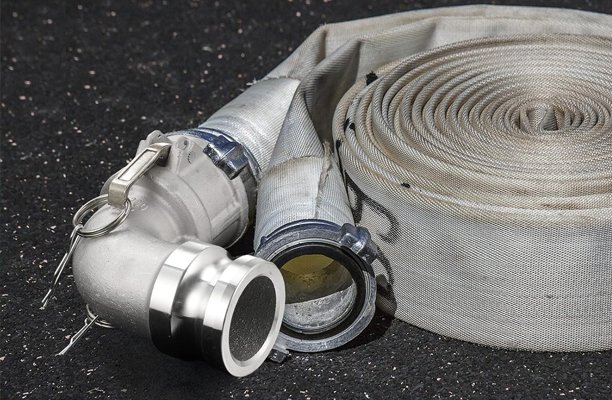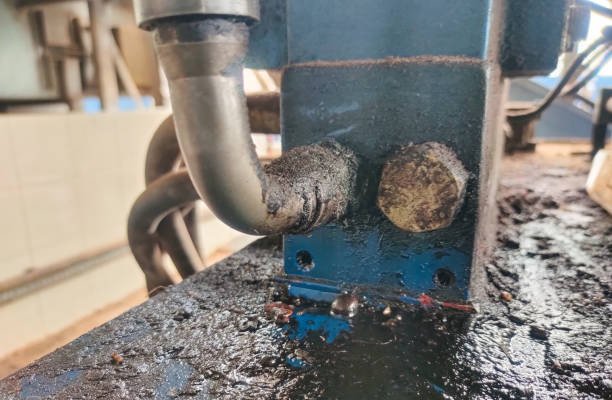Camlock fittings, also known as cam and groove couplings, are among the most practical and widely used quick-connect solutions in various industries. Known for their simplicity, reliability, and efficiency, these fittings play a vital role in safely connecting and disconnecting hoses and pipelines for fluid or material transfer. But what exactly makes camlock fittings so essential, and where are they used? Let’s explore!
What Are Camlock Fittings?
Camlock fittings, a type of quick-connect coupling, are specifically designed to connect hoses or pipes effortlessly and without the need for additional tools. Consequently, they consist of two primary components:
- Male Adapter (Camlock Plug): A component that inserts into the female coupler.
- Female Coupler (Camlock Coupler): Features cam arms that lock the connection securely when pressed down.

Key Features of Camlock Fittings:
- Quick installation without additional tools.
- Compatibility with a wide range of materials (stainless steel, aluminum, brass, polypropylene, etc.).
- Leak-proof connections for handling fluids, gases, or granular materials.
- High durability and resistance to corrosion, chemicals, and extreme temperatures.
Applications of Camlock Fittings
1. Agriculture
Camlock fittings play a pivotal role in agriculture, primarily by facilitating the efficient transfer of water, fertilizers, and pesticides. Consequently, this enhances productivity and ensures effective resource management.
- Irrigation Systems: They are used in irrigation systems to connect hoses and pipes, ensuring a seamless water flow to crops.
- Fertilizer Distribution: Farmers use camlock fittings to mix and transport liquid fertilizers to fields without leakage.
- Pesticide Application: These fittings enable the safe transfer of chemicals, ensuring no spillage or contamination.
2. Chemical Industry
The chemical industry relies heavily on camlock fittings for transferring corrosive and hazardous substances.
- Chemical Transport: Stainless steel camlocks are widely used for their resistance to chemical corrosion during the transfer of acids and alkalis.
- Mixing Applications: They connect equipment for blending and transferring chemicals in controlled environments.
- Safety Measures: Their leak-proof nature reduces the risk of exposure to hazardous chemicals.
3. Oil and Gas Industry
Camlock fittings are indispensable in the oil and gas sector for transferring fuels and lubricants.
- Fuel Handling: Aluminum camlocks are often used to load and unload fuels such as diesel and kerosene.
- Offshore Drilling: In oil rigs, camlock fittings connect pipes for transferring drilling fluids and lubricants.
- Refineries: They help in managing the flow of crude oil and other petroleum products safely.
4. Food and Beverage Industry
In industries where hygiene is paramount, camlock fittings prove to be the ideal choice, as they offer a secure and easy-to-clean connection.
- Liquid Transfer: Stainless steel camlocks are used to transfer milk, juices, and other beverages without contamination.
- Processing Equipment: These fittings connect machinery in food processing plants, ensuring seamless operations.
- Hygiene Standards: The easy-to-clean design of camlock fittings makes them suitable for maintaining stringent hygiene standards.
5. Firefighting

Firefighting operations demand quick and secure hose connections, a requirement efficiently met by camlock fittings.
- Water Supply Lines: They connect hoses to fire hydrants and pumps, ensuring a steady water flow.
- Foam Transfer: Camlocks are used to transport fire-suppressing foam solutions in emergencies.
- Durability: Their resistance to high pressure and temperature makes them ideal for firefighting applications.
6. Pharmaceutical Industry
The pharmaceutical industry requires precision and safety in handling sensitive materials, making camlock fittings a valuable asset.
- Liquid Medicines: Stainless steel camlocks are used to transfer liquid formulations with no risk of contamination.
- Sterile Environments: They connect equipment in sterile conditions, ensuring compliance with safety standards.
- Powder Handling: Camlocks facilitate the transfer of powdered ingredients in production units.
7. Marine Industry
In the marine sector, camlock fittings are used for transporting various fluids safely.
- Fuel and Oil Transfer: They connect hoses for transferring fuel and lubricants to ships.
- Water Systems: Camlocks are employed in water circulation systems onboard vessels.
- Corrosion Resistance: Marine-grade stainless steel camlocks resist saltwater corrosion, enhancing longevity.
8. Construction Industry
The construction industry leverages camlock fittings for transferring materials and maintaining equipment.
- Concrete Pumping: These fittings connect hoses for delivering concrete to construction sites.
- Water Supply: They are used in water distribution systems for construction activities.
- Durability Under Stress: Camlocks withstand rugged environments, making them a preferred choice in construction.
9. Mining Industry
In mining, the reliable performance of camlock fittings ensures efficient operation in harsh conditions.
- Slurry Transport: Camlock fittings are used to transfer slurry and mining waste.
- Water Management: They facilitate the movement of water in mining operations.
- Robust Design: Their ability to endure abrasive materials and high pressure is crucial in mining applications.
10. Automotive Industry
The automotive industry relies on camlock fittings for fluid transfer and maintenance.
- Fuel Systems: Camlocks enable efficient fuel delivery and storage in vehicles.
- Lubrication Systems: They help in transferring lubricants for automotive machinery.
- Coolant Transfer: Camlock fittings are used in cooling systems to regulate engine temperature.
Types of Camlock Fittings and Their Material Suitability
| Material | Best Applications |
|---|---|
| Stainless Steel | Food & beverage, chemicals, and high-temperature fluids. |
| Aluminum | Oil & gas, lightweight liquid transfer. |
| Brass | Corrosion-resistant systems (e.g., marine or irrigation). |
| Polypropylene | Low-pressure and chemical transport (e.g., agriculture). |
Advantages of Camlock Fittings in Industrial Applications
- Quick and Easy Installation: Camlock fittings save valuable time by enabling tool-free connections.
- Versatility: Available in multiple materials and sizes, they can handle liquids, gases, and powders.
- Durability: Their rugged construction ensures long-lasting performance, even in harsh environments.
- Leak Prevention: Proper sealing mechanisms eliminate the risk of leaks during fluid transfer.
- Cost-Effective: Reduced maintenance and downtime result in long-term savings.
Comparisons: Camlock Fittings vs Other Coupling Types
| Coupling Type | Advantages | Disadvantages |
|---|---|---|
| Camlock Fittings | Quick-connect, versatile, tool-free | May not handle extreme pressures as well as threaded connections. |
| Threaded Couplings | Secure, good for permanent systems | Time-consuming to connect or disconnect. |
| Quick Disconnects | Easy to use, widely available | Can be more expensive than camlocks. |
| Flanged Connections | Very strong, handles high-pressure systems | Requires tools and gaskets, not quick to install. |
Maintenance Tips for Camlock Fittings
- Regular Cleaning: Clean the fittings after use, especially when handling corrosive or hazardous materials.
- Inspection: Periodically check for wear, cracks, or damage.
- Proper Storage: Store in a dry, clean environment to prevent corrosion or contamination.
- Lubrication: Apply lubricant to cam arms and seals to ensure smooth operation.
Conclusion
Camlock fittings have revolutionized fluid and material transfer across numerous industries. Whether you’re in agriculture, oil and gas, or food processing, these couplings offer unmatched convenience, reliability, and efficiency. By choosing the right material and size, you can ensure seamless operations tailored to your needs.
Looking for a durable, versatile quick-connect solution? Camlock fittings might just be the perfect fit for your industrial setup.
For more insights or product recommendations, feel free to check out our resources on industrial coupling solutions.
FAQs
1. What are camlock fittings primarily used for?
Camlock fittings are used for quick and secure connections in applications involving liquid, powder, or gas transfer.
2. Which material is best for camlock fittings in chemical industries?
Stainless steel is the best choice due to its resistance to corrosion and ability to handle hazardous chemicals.
3. Can camlock fittings handle high-pressure applications?
Yes, camlock fittings, especially those made from stainless steel, are designed to handle high-pressure environments.
4. Are camlock fittings suitable for food-grade applications?
Yes, stainless steel camlock fittings are ideal for food-grade applications as they meet hygiene standards and are easy to clean.
5. How do I maintain camlock fittings?
Regular cleaning, inspection for damage, proper storage, and lubrication can prolong the lifespan of camlock fittings.
6. What industries benefit most from camlock fittings?
Industries like agriculture, chemical, oil and gas, food and beverage, and firefighting benefit significantly from camlock fittings.





